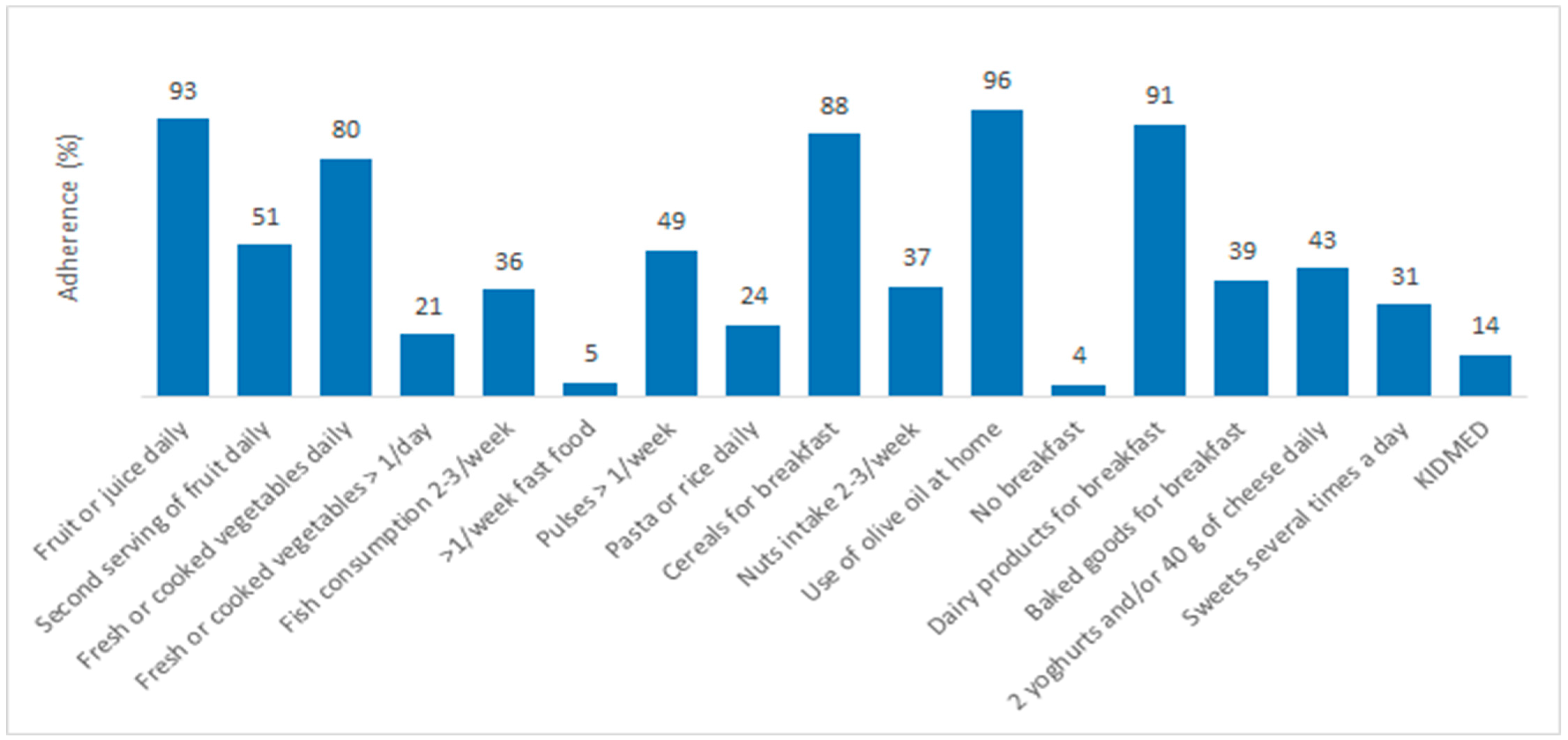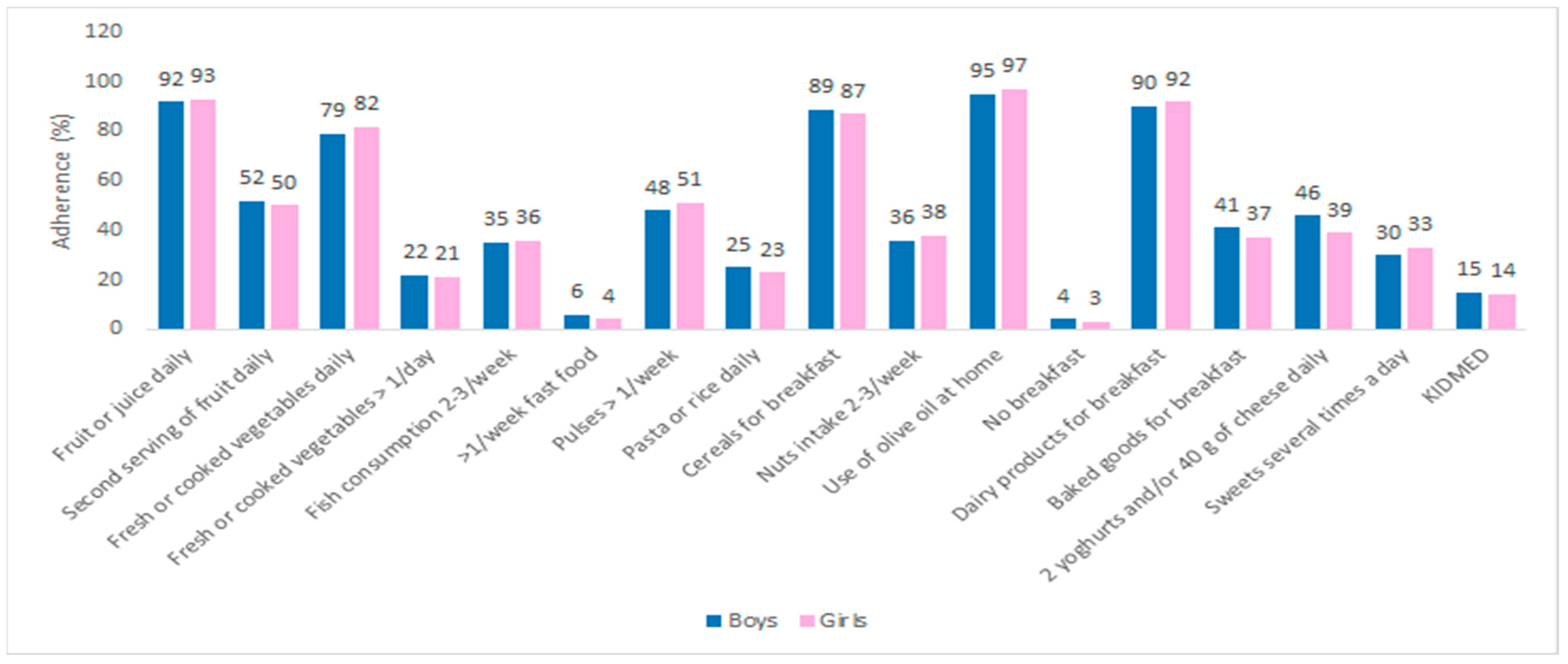Anthropometric Parameters and Mediterranean Diet Adherence in Preschool Children in Split-Dalmatia County, Croatia—Are They Related?
Abstract
:1. Introduction
2. Materials and Methods
2.1. Study Design and Population
2.2. Lifestyle Questionnaire
2.3. The Mediterranean Diet Quality Index (KIDMED)
2.4. Anthropometric Measurements
2.5. Statistical Analysis
3. Results
4. Discussion
5. Conclusions
Supplementary Materials
Author Contributions
Funding
Institutional Review Board Statement
Informed Consent Statement
Data Availability Statement
Conflicts of Interest
References
- Kim, S.Y.; Cha, S.M. Evaluation of dietary behaviors of preschool children in seoul and gyeonggi-do associated with the level of parents’ health consciousness: Using nutrition quotient for preschoolers (nq-p). Nutr. Res. Pract. 2021, 15, 248–265. [Google Scholar] [CrossRef]
- Scaglioni, S.; De Cosmi, V.; Ciappolino, V.; Parazzini, F.; Brambilla, P.; Agostoni, C. Factors influencing children’s eating behaviours. Nutrients 2018, 10, 706. [Google Scholar] [CrossRef] [PubMed] [Green Version]
- Steenbergen, E.; Krijger, A.; Verkaik-kloosterman, J.; Elstgeest, L.E.M.; Ter Borg, S.; Joosten, K.F.M.; van Rossum, C.T.M. Evaluation of nutrient intake and food consumption among dutch toddlers. Nutrients 2021, 13, 1531. [Google Scholar] [CrossRef] [PubMed]
- Llewellyn, A.; Simmonds, M.; Owen, C.G.; Woolacott, N. Childhood obesity as a predictor of morbidity in adulthood: A systematic review and meta-analysis. Obes. Rev. 2016, 17, 56–67. [Google Scholar] [CrossRef] [PubMed]
- Ryder, J.R.; Jacobs, D.R.; Sinaiko, A.R.; Kornblum, A.P.; Steinberger, J. Longitudinal Changes in Weight Status from Childhood and Adolescence to Adulthood. J. Pediatr. 2019, 214, 187–192.e2. [Google Scholar] [CrossRef]
- Juonala, M.; Magnussen, C.G.; Berenson, G.S.; Venn, A.; Burns, T.L.; Sabin, M.A.; Raitakari, O.T. Childhood Adiposity, Adult Adiposity, and Cardiovascular Risk Factors. N. Engl. J. Med. 2011, 365, 1876–1885. [Google Scholar] [CrossRef] [Green Version]
- Musić Milanović, S.; Lang Morović, M.; Križan, H. European Childhood Obesity Initiative, Croatia 2018/2019 (CroCOSI); Croatian Institute of Public Health: Zagreb, Croatia, 2021. [Google Scholar]
- Bach-Faig, A.; Berry, E.M.; Lairon, D.; Reguant, J.; Trichopoulou, A.; Dernini, S.; Medina, F.X.; Battino, M.; Belahsen, R.; Miranda, G.; et al. Mediterranean diet pyramid today. Science and cultural updates. Public Health Nutr. 2011, 14, 2274–2284. [Google Scholar] [CrossRef] [Green Version]
- Sofi, F.; Abbate, R.; Gensini, G.F.; Casini, A. Accruing evidence on benefits of adherence to the Mediterranean diet on health: An updated systematic review and meta-analysis. Am. J. Clin. Nutr. 2010, 92, 1189–1196. [Google Scholar] [CrossRef] [Green Version]
- Jennings, A.; Welch, A.; Van Sluijs, E.M.F.; Griffin, S.J.; Cassidy, A. Diet quality is independently associated with weight status in children aged 9–10 years. J. Nutr. 2011, 141, 453–459. [Google Scholar] [CrossRef] [PubMed] [Green Version]
- Serra-Majem, L.; Ribas, L.; Ngo, J.; Ortega, R.M.; García, A.; Pérez-Rodrigo, C.; Aranceta, J. Food, youth and the Mediterranean diet in Spain. Development of KIDMED, Mediterranean Diet Quality Index in children and adolescents. Public Health Nutr. 2004, 7, 931–935. [Google Scholar] [CrossRef]
- Kolčić, I.; Relja, A.; Gelemanović, A.; Miljković, A.; Boban, K.; Hayward, C.; Rudan, I.; Polašek, O. Mediterranean diet in the southern Croatia—Does it still exist? Croat. Med. J. 2016, 57, 415–424. [Google Scholar] [CrossRef] [Green Version]
- Pereira-Da-Silva, L.; Rêgo, C.; Pietrobelli, A. The diet of preschool children in the Mediterranean countries of the European Union: A systematic review. Int. J. Environ. Res. Public Health 2016, 13, 572. [Google Scholar] [CrossRef] [PubMed] [Green Version]
- Schröder, H.; Mendez, M.A.; Gomez, S.F.; Fíto, M.; Ribas, L.; Aranceta, J.; Serra-Majem, L. Energy density, diet quality, and central body fat in a nationwide survey of young Spaniards. Nutrition 2013, 29, 1350–1355. [Google Scholar] [CrossRef]
- Costarelli, V.; Koretsi, E.; Georgitsogianni, E. Health-related quality of life of Greek adolescents: The role of the Mediterranean diet. Qual. Life Res. 2013, 22, 951–956. [Google Scholar] [CrossRef] [PubMed]
- WHO. AnthroPlus Software. Available online: https://www.who.int/tools/growth-reference-data-for-5to19-years/application-tools (accessed on 12 May 2021).
- WHO. Obesity and Overweight. Available online: https://www.who.int/news-room/fact-sheets/detail/obesity-and-overweight (accessed on 12 May 2021).
- Labayen Goñi, I.; Arenaza, L.; Medrano, M.; García, N.; Cadenas-Sanchez, C.; Ortega, F.B. Associations between the adherence to the Mediterranean diet and cardiorespiratory fitness with total and central obesity in preschool children: The PREFIT project. Eur. J. Nutr. 2018, 57, 2975–2983. [Google Scholar] [CrossRef] [PubMed] [Green Version]
- Farajian, P.; Risvas, G.; Karasouli, K.; Pounis, G.D.; Kastorini, C.M.; Panagiotakos, D.B.; Zampelas, A. Very high childhood obesity prevalence and low adherence rates to the Mediterranean diet in Greek children: The GRECO study. Atherosclerosis 2011, 217, 525–530. [Google Scholar] [CrossRef] [PubMed]
- Salcin, L.O.; Karin, Z.; Damjanovic, V.M.; Ostojic, M.; Vrdoljak, A.; Gilic, B.; Sekulic, D.; Lang-Morovic, M.; Markic, J.; Sajber, D. Physical activity, body mass, and adherence to the mediterranean diet in preschool children: A cross-sectional analysis in the split-dalmatia county (Croatia). Int. J. Environ. Res. Public Health 2019, 16, 3237. [Google Scholar] [CrossRef] [Green Version]
- Cabrera, S.G.; Fernández, N.H.; Hernández, C.R.; Nissensohn, M.; Román-Viña, B.; Serra-Majem, L. Test KIDMED; prevalencia de la Baja Adhesión a la Dieta Mediterránea en Niños y Adolescentes; Revisión Sistemática. Nutr. Hosp. 2015, 32, 2390–2399. [Google Scholar] [CrossRef]
- Sahingoz, S.A.; Sanlier, N. Compliance with Mediterranean Diet Quality Index (KIDMED) and nutrition knowledge levels in adolescents. A case study from Turkey. Appetite 2011, 57, 272–277. [Google Scholar] [CrossRef]
- Rito, A.I.; Dinis, A.; Rascôa, C.; Maia, A.; Mendes, S.; Stein-Novais, C.; Lima, J. Mediterranean Diet Index (KIDMED) Adherence, Socioeconomic Determinants, and Nutritional Status of Portuguese Children: The Eat Mediterranean Program. Port. J. Public Health 2018, 36, 141–149. [Google Scholar] [CrossRef]
- Ventura, A.K.; Worobey, J. Early influences on the development of food preferences. Curr. Biol. 2013, 23, R401–R408. [Google Scholar] [CrossRef] [PubMed] [Green Version]
- Gibson, E.L.; Wardle, J.; Watts, C.J. Fruit and vegetable consumption, nutritional knowledge and beliefs in mothers and children. Appetite 1998, 31, 205–228. [Google Scholar] [CrossRef] [PubMed] [Green Version]
- Agnoli, C.; Sieri, S.; Ricceri, F.; Giraudo, M.T.; Masala, G.; Assedi, M.; Panico, S.; Mattiello, A.; Tumino, R.; Giurdanella, M.C.; et al. Adherence to a Mediterranean diet and long-term changes in weight and waist circumference in the EPIC-Italy cohort. Nutr. Diabetes 2018, 8, 22. [Google Scholar] [CrossRef] [PubMed]
- Tognon, G.; Moreno, L.A.; Mouratidou, T.; Veidebaum, T.; Molnár, D.; Russo, P.; Siani, A.; Akhandaf, Y.; Krogh, V.; Tornaritis, M.; et al. Adherence to a Mediterranean-like dietary pattern in children from eight European countries. The IDEFICS study. Int. J. Obes. 2014, 38, S108–S114. [Google Scholar] [CrossRef] [Green Version]
- Kanellopoulou, A.; Giannakopoulou, S.P.; Notara, V.; Antonogeorgos, G.; Rojas-Gil, A.P.; Kornilaki, E.N.; Konstantinou, E.; Lagiou, A.; Panagiotakos, D.B. The association between adherence to the Mediterranean diet and childhood obesity; the role of family structure: Results from an epidemiological study in 1728 Greek students. Nutr. Health 2021, 27, 39–47. [Google Scholar] [CrossRef]
- Naveed, S.; Lakka, T.; Haapala, E.A. An overview on the associations between health behaviors and brain health in children and adolescents with special reference to diet quality. Int. J. Environ. Res. Public Health 2020, 17, 953. [Google Scholar] [CrossRef] [Green Version]
- Dougkas, A.; Barr, S.; Reddy, S.; Summerbell, C.D. A critical review of the role of milk and other dairy products in the development of obesity in children and adolescents. Nutr. Res. Rev. 2019, 32, 106–127. [Google Scholar] [CrossRef] [Green Version]
- Mazaraki, A.; Tsioufis, C.; Dimitriadis, K.; Tsiachris, D.; Stefanadi, E.; Zampelas, A.; Richter, D.; Mariolis, A.; Panagiotakos, D.; Tousoulis, D.; et al. Adherence to the Mediterranean diet and albuminuria levels in Greek adolescents: Data from the Leontio Lyceum ALbuminuria (3L study). Eur. J. Clin. Nutr. 2011, 65, 219–225. [Google Scholar] [CrossRef] [Green Version]




| Sex [n (%)] | |
|---|---|
| Boys | 310 (51.8) |
| Girls | 288 (48.2) |
| Age (years) [Mean (SD)] | 5 (1) |
| Age groups [n (%)] | |
| <4 years | 15 (2.5) |
| 4–5 years | 290 (48.5) |
| 6–7 years | 293 (49) |
| Body height (m) [Mean (SD)] | 1.17 (0.09) |
| Body weight (kg) [Median (IQR)] 12–40.5 | 21.2 (18.6–24.3) |
| Waist circumference (cm) [Median (IQR)] 43–76 | 54 (51–56) |
| Mid-upper arm circumference (cm) [Median (IQR)] 13–24 | 17.7 (16.5–19) |
| z-score [Median (IQR)] | 0.25 (−0.40–0.92) |
| Nutritional status regarding z-score [n (%)] | |
| ≤−1.04 | 54 (9) |
| >−1.04, <1.04 | 420 (70.2) |
| ≥1.04 | 124 (20.7) |
| Supplements [n (%)] | 124 (20.7) |
| Food allergies [n (%)] | >35 (5.9) |
| Number of meals [n (%)] | |
| 3–4/day | 117 (19.6) |
| 4–5/day | 396 (66.2) |
| >5/day | 85 (14.2) |
| Length of kindergarten stay [n (%)] | |
| Half a day programme (5 h) | 8 (1.3) |
| Half a day programme (6 h) | 53 (8.9) |
| Half a day programme (6 h; lunch included) | 19 (3.2) |
| Full day (10 h) | 518 (86.6) |
| WC | MUAC | |
|---|---|---|
| Second serving of fruit daily | −0.085 (0.04 *) | −0.050 (0.23 *) |
| Fresh or cooked vegetables > 1/day | −0.091 (0.03 *) | −0.101 (0.01 *) |
Publisher’s Note: MDPI stays neutral with regard to jurisdictional claims in published maps and institutional affiliations. |
© 2021 by the authors. Licensee MDPI, Basel, Switzerland. This article is an open access article distributed under the terms and conditions of the Creative Commons Attribution (CC BY) license (https://creativecommons.org/licenses/by/4.0/).
Share and Cite
Bučan Nenadić, D.; Kolak, E.; Selak, M.; Smoljo, M.; Radić, J.; Vučković, M.; Dropuljić, B.; Pijerov, T.; Babić Cikoš, D. Anthropometric Parameters and Mediterranean Diet Adherence in Preschool Children in Split-Dalmatia County, Croatia—Are They Related? Nutrients 2021, 13, 4252. https://doi.org/10.3390/nu13124252
Bučan Nenadić D, Kolak E, Selak M, Smoljo M, Radić J, Vučković M, Dropuljić B, Pijerov T, Babić Cikoš D. Anthropometric Parameters and Mediterranean Diet Adherence in Preschool Children in Split-Dalmatia County, Croatia—Are They Related? Nutrients. 2021; 13(12):4252. https://doi.org/10.3390/nu13124252
Chicago/Turabian StyleBučan Nenadić, Dora, Ela Kolak, Marija Selak, Matea Smoljo, Josipa Radić, Marijana Vučković, Bruna Dropuljić, Tanja Pijerov, and Dora Babić Cikoš. 2021. "Anthropometric Parameters and Mediterranean Diet Adherence in Preschool Children in Split-Dalmatia County, Croatia—Are They Related?" Nutrients 13, no. 12: 4252. https://doi.org/10.3390/nu13124252
APA StyleBučan Nenadić, D., Kolak, E., Selak, M., Smoljo, M., Radić, J., Vučković, M., Dropuljić, B., Pijerov, T., & Babić Cikoš, D. (2021). Anthropometric Parameters and Mediterranean Diet Adherence in Preschool Children in Split-Dalmatia County, Croatia—Are They Related? Nutrients, 13(12), 4252. https://doi.org/10.3390/nu13124252






